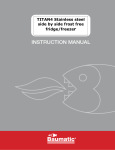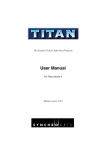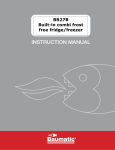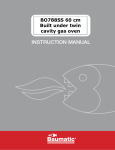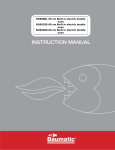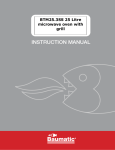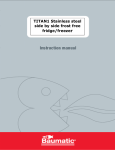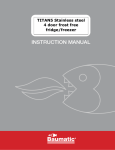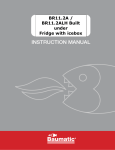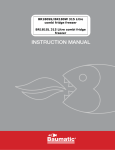Download Baumatic TITAN4 User manual
Transcript
TITAN4 Stainless steel side by side frost free fridge/freezer USER MANUAL FOR YOUR BAUMATIC TITAN4 Stainless steel side by side 608 litre frost free fridge/freezer NOTE: This User Instruction Manual contains important information, including safety & installation points, which will enable you to get the most out of your appliance. Please keep it in a safe place so that it is easily available for future reference, for you or any person not familiar with the operation of the appliance. GS 11/10/10 2 Contents Environmental note Important safety information Specifications of your fridge freezer Dimensions of the appliance Energy efficiency class Cubic capacities Specifications of your appliance Description of the appliance Description of the product features 4 5–6 7 - 10 7 7 7 7-8 8-9 9-10 Using your Baumatic fridge freezer Before switching on During first use Control panel Turning on the appliance Setting the thermostat in the freezer Setting the thermostat in the fridge Turning on the super freezer option Turning on the super refrigerator option Arranging and storing food in the fridge section freezer compartment The Freezing fresh food Tips on freezing Activating the child lock 11-18 11 11 12-13 13 13 14 15 15 16-17 17 17-18 18 18 The dispenser Before first use Using the dispenser The ice maker Dispenser and ice maker warnings Locking the ice maker Removing and replacing the ice cube storage case Water filter change icon 19-22 19 19 20 20-21 21 21 21-22 Important user information Saving energy when using your fridge-freezer Cleaning and maintenance freezer compartment Defrosting the Replacing the water filter Replacing the light bulb 22 22 - 23 23-27 26-27 27 27 Installation Electrical connection Positioning Installation preparation Removing the freezer door Removing the fridge door Replacing the freezer door Replacing the fridge door The water inlet hose and water filter Connecting the water inlet hose and water filter Levelling the appliance and adjusting the doors Fitting the front cover 28-35 28 29 30 30-31 31-32 32 33 33 34-35 35 35 Troubleshooting Contact details 36-38 39 3 Environmental note o The packaging materials that Baumatic uses are environmentally friendly and can be recycled. o Please discard all packaging material with due regard for the environment. 4 Important safety information Your safety is of the utmost importance to Baumatic. Please make sure that you read this instruction booklet before attempting to install or use the appliance. If you are unsure of any of the information contained in this booklet, please contact the Baumatic Advice Line. IMPORTANT: Any installation work must be carried out by a qualified electrician or competent person. Use of the appliance o Your appliance is only designed to be used in the home. It is suitable for storing food that needs to be chilled and refrigerated. If it is used for any other purpose or it is not used correctly, then Baumatic Ltd. will accept no liability for any damage that is caused. o Altering the specification of the appliance must not be attempted for reasons of safety. Before using your appliance o Check the appliance for any signs of transport damage. If you notice any damage, then you should not connect your appliance to your mains supply and should contact your retailer. Refrigerant o Your appliance contains R600a refrigerant, which is a natural gas that does not contain CFCs that can damage the environment. However it is a flammable substance, therefore care should be taken: During the transportation and installation of the appliance, make sure that the refrigeration pipework does not get damaged. If it does become damaged then sources of ignition and open flames should be avoided. Also the room that the appliance is situated in should be thoroughly ventilated. o Do not place any objects on top of the appliance, as this may damage the table top. 5 Child safety o Packaging material should be kept away from children. o Children should not be allowed to touch the controls or play with the appliance. General safety o Do not pull on the power supply cable to remove the plug from your mains supply socket. o Do not pull out or insert the plug with wet hands. o Do not attempt to use your appliance outdoors or any place where it is likely to come into contact with the elements. o Before cleaning the appliance or performing maintenance work, ensure that the appliance has been disconnected from your mains supply. o Never allow the back coils of the appliance to come into contact with the wall surface. o Always ensure that the location where you are installing your appliance is free of stored items such as papers and other flammable materials. o Never block the ventilation openings of the appliance, either on the inside or its exterior. o It is vital to keep your appliance well ventilated, so that there is proper air flow between the bottom of the unit and the plinth/kick plate which it is sitting on. o Do not place electrical devices inside of the appliance, such as mixers or ice cream makers. Service You should not attempt to repair the appliance yourself, as this could cause injury or a more serious malfunction. If you require a service call then please contact the Baumatic Customer Care Department. 6 Specifications of your fridge freezer Dimensions of your appliance o Height: o Width: o Depth: 1770 mm 906 mm 735 mm Energy efficiency class o Energy class: A Cubic capacities o o o o Gross capacity (fridge): Gross capacity (freezer): Net capacity (fridge): Net capacity (freezer): 380 228 370 179 litres litres litres litres Specifications of the appliance o o o o o o o o o o o o o o o o o o Frost free fridge and freezer Turbo cooling system Digital control panel Ice maker Water dispenser 2 x Adjustable safety glass shelves 2 x Salad crispers 1 x Salad crisper shelf 1 x Egg case 1 x Butter compartment 3 x General door shelves 1 x Bottle shelf 3 x Freezer shelves 4 x Freezer door storage compartments 2 x Freezer drawers 1 x Ice cube tray 1 x Xpress can chiller Door storage 7 IMPORTANT: When you install your appliance it is important to bear in mind its climatic rating. In order to find out the climatic rating of your appliance, you should check the rating plate. The rating plate is located on the front left edge of the inside of the fridge section. You will need to open the door of your appliance to be able to find it. The rating plate will indicate the ambient temperature range that your appliance will function correctly within. Description of the appliance Freezer 1) Door storage compartment (for short-term storage of food and ice-cream). 2) Door storage compartment (for storing frozen food). 3) Freezer shelf (for storing frozen foods such as meat, fish, icecream etc). 4) Freezer case (for storing dried food, fish or meat for long periods of time). 8 5) Ice-maker and storage. Refrigerator 6) Xpress can chiller, a quick cooling compartment (for storing beverages). 7) Refrigerator shelf (for storing common foods). 8) Egg case (do not use the case for storing ice cubes or place it in the freezer). 9) Salad/vegetable crisper drawer 10) Fruit crisper drawer 11) Water filter. 12) Multi-plus zone (storage space for general foods). 13) Refreshment pocket (for storing refrigerated foods, milk, juice, beer bottles etc). Description of the product features Shelves o The shelves may be placed in any of the guide slots within the interior of the appliance. They are protected from sliding out. o To remove a shelf, take off all of the items that are stored on the shelf that you want to remove. Then lift the front of the shelf and carefully pull it out of the grooves. Freezer section door storage compartments o The top door storage compartment should not have ice cream or foods that are going to be stored for a long period of time put in it. o IMPORTANT: IT IS IMPORTANT THAT NONE OF THE SHELVES THAT SIT IN THE DOOR ARE OVERLOADED, AS THIS WILL DRASTICALLY REDUCE THEIR WORKING LIFE. Fridge section door storage compartments o The door liner holds various shelves, which are suitable for storing eggs, cheese, butter and yogurt. As well as smaller packages, tubes, cans etc. o The lower shelves should be used for storing reasonably sized bottles. o IMPORTANT: IT IS IMPORTANT THAT NONE OF THE SHELVES THAT SIT IN THE DOOR ARE OVERLOADED, AS THIS WILL DRASTICALLY REDUCE THEIR WORKING LIFE. 9 Movable egg container o This case can be placed on any shelf, depending on how the food in your fridge is arranged. Fruit and salad/vegetable crisper drawers o For storing fruits, salad and vegetables, these drawers are designed to keep the contents fresh for as long as possible. o Care should be taken when storing tropical fruit (bananas and pineapples etc) and tomatoes. As these types of items can easily deteriorate in a lower temperature. Dispenser o Will dispense chilled water or cubed ice. Digital control panel o Shows the temperature that the fridge and freezer are set at. o Shows what option the water dispenser is set at. o Shows whether the child lock is engaged. o Shows whether the water filter needs changing. 10 Using your Baumatic fridge freezer Before switching on o Make sure that it has been installed by a suitably qualified person, as per the information contained in Baumatic’s installation instructions. o After delivery, wait for eight hours before connecting the appliance to your mains supply. This means that any refrigerant gasses that may have been disturbed during the transportation process are allowed to settle. o The outside of the appliance and the removable accessories contained within it, should be cleaned with a solution of liquid detergent and water. o The interior of the appliance should be cleaned with a solution of sodium bicarbonate dissolved in lukewarm water. The interior and accessories should be thoroughly dried, after the cleaning process has been completed. o There can be an odour when you first switch on the appliance. It will lessen as the appliance starts to cool. During first use o When you first switch on the appliance, the compressor will run continuously for approximately 24 hours or until the fridge freezer reaches a cool enough temperature. o During this period of time, you should try not to open the door frequently or place a large amount of food within the appliance. o If the unit is switched off or unplugged, you must allow at least 5 minutes before restarting the appliance on the thermostat or reconnecting it to your mains supply. 11 Control panel The control panel is located in the front of the freezer door, above the dispenser. 1) Freeze-set selection button for freezer compartment temperature. 2) Light / reset filter button. Press once to turn the dispenser light on. Press and hold for three seconds to reset or after filter exchange. 3) Alarm display. An alarm may sound if the temperature abnormally rises due to a power cut for example. To turn an alarm off, press the lock button once. 4) Safety lock display. 5) Water filter change icon. The icon will approximately six months after initial power input. flicker 6) Water dispensing button. The water symbol will light up when button is pressed. 7) Ice dispensing selection button. 12 8) Ice-maker lock button. 9) Refrigerator-set selection button for refrigerator temperature. 10) Lock button for control panel. Press button once to prevent settings being accidently changed. To release the lock, press and hold for longer than three seconds and the display will go out. Turning on the appliance o You switch on your appliance by connecting it to your mains supply. Setting the thermostat in the freezer o Press the FREEZER SET selection button to set the temperature in the freezer section. o The temperature that you have selected will show in the digital display next to the FREEZER SET selection button. o The temperature shown in the display will count through in the sequence shown below:- o We would recommend that the freezer section is set to a minimum temperature of -18°C. o When the desired temperature appears on the digital display, release the FREEZER SET selection button, after a few seconds the temperature will be selected. o On the maximum setting (-22°C), the freezer section will work harder to maintain a lower temperature. There is no need to run your appliance on this setting for prolonged periods and you should return the temperature setting to (-18°C). 13 Setting the thermostat in the fridge o Press the REFRIGERATOR SET selection button to set the temperature in the fridge section. o The temperature that you have selected will show in the digital display next to the REFRIGERATOR SET selection button. o The temperature shown in the display will count through in the sequence shown below:- o We would recommend that the fridge section is set to a minimum temperature of 5°C. o When the desired temperature appears on the digital display, release the REFRIGERATOR SET selection button, after a few seconds the temperature will be selected. o On the maximum setting (2°C), the fridge section will work harder to maintain a lower temperature. There is no need to run your appliance on this setting for prolonged periods and you should return the temperature setting to (4°C or 5°C). o IMPORTANT: The ambient temperature of the room, the temperature of food and the amount of food that has been placed in the fridge freezer and how often the door is opened, will all affect the temperature being maintained by the appliance. 14 Turning on the super freezer option This setting should be used before and whilst you are freezing fresh food, it will ensure that a powerful supply of cold air enters the freezer compartment. o Press the FREEZER SET selection button and hold until the symbol appears next to the temperature display. o To turn the super freeze function off, press the FREEZER SET selection button again. IMPORTANT: This mode should only be used prior to and when freezing fresh food. You should not run the appliance in super freezer mode for prolonged periods. Turning on the super refrigerator option This setting should be used if you want to chill something quickly, it will ensure that a powerful supply of cold air enters the fridge compartment. o Press the REFRIGERATOR SET selection button and hold until the symbol appears on the temperature display. o To turn the super cooling function REFRIGERATOR SET selection button again. off, press the IMPORTANT: You should not run the appliance in super refrigerator mode for prolonged periods. 15 Arranging and storing food in the fridge section o Warm food or evaporating liquids should not be stored in your refrigerator, as this will increase the humidity inside of the appliance. o All foods should be wrapped or covered, this is particularly important if the food has a strong flavour. You should use polythene bags or sheets, aluminium foil, wax paper. Liquids should be stored in covered containers or bottles. o To maximise the space inside of the fridge section, any excessive packaging on the food should be removed. o Quickly perishable food should be stored at the back of the refrigerator, which is the coldest part of the appliance. o No food items should be allowed to come into contact with the back wall of the refrigerator. o Make sure that you arrange food in such a way that the door can close completely. Particular attention should be given to bottles that may protrude when placed on shelves inside the main section of the refrigerator. o Some organic solutions, such as the oils in lemon/orange peel and acid in butter, can cause damage to the plastic parts contained inside of the refrigerator. o Do not open the refrigerator door too often or leave the door open for long periods of time, as this will increase the temperature inside of the appliance. o Meat should be wrapped in polythene bags and then placed on the glass shelf above the vegetable drawer. (Meat should only be stored in this manner for one or two days at the most). o Cold dishes/cooked food should be covered and can be placed on any shelf or in the chiller case. o Salad and vegetables should be cleaned thoroughly and placed in the salad/vegetable drawers. o Fruit should be cleaned thoroughly and placed in the fruit drawer. o Cheese and butter should be placed in airtight containers, or they can be wrapped in aluminium foil or polythene bags. As much air as possible should be removed from the bags. 16 o Milk bottles should have a cap on them and be stored on the bottle shelves that sit in the door. o Garlic, potatoes, onions and bananas should only be stored in a refrigerator IF they are stored in airtight containers. The freezer compartment The freezer compartment is suitable for storing and freezing food. o The freezer compartment temperature must have already reached -18 degrees centigrade (or lower) before you attempt to store food that is already frozen or freezing fresh food. o The freezer compartment is only able to freeze a certain quantity of fresh food at one time. The maximum amount of fresh food (in kilograms) that can be frozen in a 24 hour period is listed on the rating plate. o Warm food should be allowed to cool down before you attempt to freeze it. If you place warm food in the freezer compartment, then the increased humidity will cause quicker ice formation and increase the amount of power that the appliance uses. o The guidance of the food manufacturer should be followed, in regard to the maximum storage time. o Thawed foods must not be frozen for a second time. Freezing fresh food o To freeze the maximum quantity of fresh food specified above, you should turn the SUPER FREEZER function on 24 hours prior to attempting freezing. o To freeze smaller quantities of fresh food, you should turn on the SUPER FREEZER function a few hours prior to attempting freezing. o Fresh food should be packed into airtight containers or packaging. This will help to make sure that the food doesn’t dry out or lose its flavour. It will also ensure that flavour does not transfer from other foods. 17 o Do not allow fresh food to touch items that are already frozen. o After 24 hours you should check that the fresh food is satisfactorily frozen. If it is then you should turn the SUPER FREEZER function off again to return the appliance to normal operation. Tips on freezing o Freezer bags, polythene wraps, aluminium foil (extra thick) and special cans for frozen foods are suitable packaging for storing frozen goods in. o Tape, rubber bands or plastic clips are suitable for sealing bags and wrappings. o Before sealing a suitable bag, you should compress the air out of it, as this will help the food to freeze more easily. o Flat packages freeze more easily. o If you are freezing liquid, then do not fill the container to the brim. Liquids will expand when being frozen. o Do not place bottles (glass or tin) containing liquids (especially sparkling liquids) into the freezer as this could cause the bottle to burst during freezing. Activating the child lock Your appliance is fitted with a lock that will prevent a child from changing the temperature settings or any other settings that can be activated from the control panel. o Press the ice-maker lock button once and the child lock will activate. The lock icon will light on the display. o To switch off the child lock, press and hold the lock button for longer than three seconds. The lock icon on the display will go out. 18 The dispenser When your fridge/freezer is first connected to your mains supply, it will automatically select chilled water mode and the water symbol will light. Before first use You should not attempt to dispense ice for 24 hours after the appliance is first connected to your mains supply. o Once the fridge and freezer sections have cooled sufficiently place a cup against the PUSH pad in the dispenser and pour out a couple of glasses of water. o IMPORTANT: These first couple of glasses should not be drunk and the water should be poured down the sink. Using the dispenser o The dispenser can produce chilled water and cubed ice. o Press the WATER or ICE dispensing button to select what you want the dispenser to produce. o Place a cup against the pad in the dispenser and push it, after a few seconds it will dispense water or cubed ice. What comes out of the dispenser will depend on what option you selected before pushing the pad. o You should place the glass directly underneath the water/ice chute and not rest it on the base of the dispenser. Otherwise water/ice can spill or splash. o When the dispenser is producing ice, you should remove the cup/glass from the dispenser chute when it is half full, otherwise you may get ice overflowing or the dispenser outlet could become blocked. o Shortly after ice has come out, you will hear a snapping sound which is a shut off valve operating; this stops further ice from being dispensed. o 1 hour after you have dispensed cubed or crushed ice, the selection mode will return to chilled water automatically. 19 The ice maker o 14 - 15 times a day, the ice maker will automatically produce approximately 10 ice cubes. o These ice cubes will be stored in the ice cube storage case. o If the ice storage case becomes full, then the automatic ice making operation will stop. o It is normal for there to be banging sounds, whilst the ice is being deposited into the ice cube storage case. o If you use the dispenser several times in quick succession, then the ice cube storage case may empty. You will then need to wait approximately 24 hours for the ice maker to refill it. Dispenser and ice maker warnings o Avoid using fragile cups or crystal glasses if you are dispensing cubed or crushed ice, as damage could be caused to them. o To prevent a bad odour then you should regularly remove the ice from the ice cube storage case. o If you have not dispensed ice for a period of time, then clear all of the ice out of the ice cube storage case and let the appliance produce fresh ice. o DO NOT USE ICE THAT HAS BEEN STORED IN THE ICE CUBE STORAGE CASE FOR A LONG TIME. o IMPORTANT: If you find that either the cubed or crushed ice is discoloured, do not use the ice. o o o o Remove all of the ice in the ice cube storage case. Let fresh ice form. If the ice is still discoloured then change the water filter. If the ice is STILL discoloured after changing the water filter, then contact the Baumatic Customer Care Department. o If there is a power cut you should remove all ice from the ice cube storage case. If you leave the ice in the storage case, then it will melt and water will flow into the main section of the freezer. o DO NOT insert your fingers or any tools into the dispenser outlet. 20 o If ice cubes do not dispense, then pull out the ice cube storage case and separate any ice cubes that may have got stuck together. Then try to dispense ice again. Locking the ice maker o Before cleaning the ice cube storage case or if you do not want the ice maker to produce ice, press the LOCK ICE MAKER button. o You should then remove all ice from the ice cube storage case. o To reactivate the ice maker you should press the LOCK ICE MAKER button again. Removing and replacing the ice cube storage case o Pull the storage case forwards remove it from the freezer. to o To put the storage case back into position, locate it into the side grooves of the cabinet and push it back into place. o If the storage case does not fully slide back into position, remove it from the freezer again. Rotate the coil inside of the case a quarter of a turn and then slide the storage case back into place. Water filter change icon o Six months after you connect your appliance to the mains supply for the first time, the WATER FILTER CHANGE icon will come on. o After changing the water filter (see manual section for details), press and hold the LIGHT BUTTON until the FILTER CHANGE icon switches off. 21 o If you change the water filter before the FILTER CHANGE icon comes on, then you should still press and hold the LIGHT BUTTON for 5 seconds to reset the countdown. Important user information IMPORTANT: Care should be taken to make sure that the airflow duct vents on the rear interior wall of the fridge and freezer sections are not blocked. IMPORTANT: If your mains power supply fails, then the food inside of the freezer section will be preserved for a 12 hour period. After 12 hours the food should be removed from the freezer section and consumed as quickly as possible. IMPORTANT: If power is cut to the appliance, when power is restored it will take approximately 30 minutes for the compressor to start running again. Saving energy when using your fridge-freezer Installing: o Install the appliance in a cool position. If it is placed in direct sunlight or next to an oven or other heat source, the energy consumption can increase substantially. o Ensure the appliance is installed with the correct ventilation requirements. Restricting ventilation can increase the energy consumption by 15%. Cleaning and Maintenance: o Occasionally clean the condenser coils (if present) at the back of the appliance to maintain a high performance level. o Clean the door gasket with warm water or a neutral detergent that leaves no residue. A tight-sealing door gasket is critical to the efficiency of your appliance. Usage: o Do not open the door repeatedly or more frequently than you have to. 22 o Do not set the thermostat too low. A change of just one degree can effect the energy consumption by 5%. Use a thermometer to check the temperature. o The freezer compartment should operate at -15 to -18 degrees Celsius. The refrigerator should operate at around 3 to 4 degrees Celsius. o Allow food to sufficiently cool before putting it in the appliance (but don’t let it sit at room temperature for too long). o In the freezer compartment, food packages should be scattered and never grouped or stacked together until they are completely frozen. o If you are going away for a long period of time, turn off the appliance, empty and clean it and leave the door ajar. o If you have a second appliance that is not used, make sure that it is stored with the power off and the door left ajar until it is actually required. Disposing: o If you're going to throw out your old fridge, see if there's a chlorofluorocarbons (CFCs) recycler in your area. The government department which looks after the environment in your area may be able to help you. Cleaning and maintenance WARNING: PLEASE ENSURE THAT YOUR APPLIANCE IS DISCONNECTED FROM YOUR MAINS SUPPLY BEFORE ATTEMPTING TO CLEAN IT. o Do not clean the appliance by pouring water onto it or spraying water over it. o The refrigerator and freezer compartment should be cleaned periodically, using a solution of bicarbonate of soda and lukewarm water. 23 o Clean the accessories separately with soap and water. Do not clean them in a dishwasher. o Do not use abrasive products, detergents or soaps. o After washing the appliance, wipe over the area that you have cleaned with a damp cloth and then dry it thoroughly. o When cleaning is complete, dry your hands and then reconnect the plug to your mains supply. IMPORTANT: Before attempting any of the cleaning steps shown below, you should remove all items from the shelves and compartments that you are cleaning. Fridge and freezer door compartments 1) To remove a fridge or freezer door compartment, hold both ends and pull upwards. Fridge and freezer shelves 1) Open the appliance doors fully. 2) To remove a shelf, pull them forwards. Salad/Vegetable and fruit drawers 1) To remove a drawer, lift up a little and pull forward. 24 Interior parts 1) Use a cloth that has been wetted with water and mild (neutral) detergent and wipe over the interior parts of the appliance. 1) Use a cloth that has been wetted with water and mild (neutral) detergent and wipe around the door seal. 1) At least once a year, remove any dust that has gathered on the grill at the rear of the appliance, using a vacuum cleaner. 1) Take out the spillage grill and use a cloth to remove water from and clean this area. Door seal Rear grill Dispenser shelf DO NOT USE ANY FORM OF ASOLINE (PETROL) OR BENZENE (BENZOL) THINNERS ON ANY AREA OF THE APPLIANCE. AS THESE CHEMICALS CAN DAMAGE THE SURFACES. 25 Defrosting the freezer compartment Your appliance is frost free, so you should not need to manually defrost the freezer section. However if for example the door is left open for a prolonged period of time or the door gasket is not sealing correctly, then you could get ice building in the freezer section. If this occurs, then you should follow the steps below. o The day before you defrost, you should select the SUPER FREEZER option; this will make sure that the food contained in the compartment is frozen properly. o Whilst defrosting the appliance, the food should be removed from the compartment and wrapped in several layers of paper and stored in a cool place. The foods rise in temperature will shorten its storage life and therefore the food should be used within a relatively short period of time. o DO NOT PLACE FOOD BACK IN THE COMPARTMENT THAT HAS STARTED TO THAW. FREEZER o Turn the appliance off by turning off the power supply to the fridge freezer. o Remove the drawers and shelves from the freezer section and leave the door to the freezer compartment open. You can place a bowl of warm water inside the freezer compartment to speed up the defrost process. o You can use a sponge to mop up the defrost water that will run into the bottom of the freezer section. o IMPORTANT: You should place some old towels on the flooring that is immediately in front of the appliance. In case any defrost water comes out of the freezer section and onto the floor. o Once all the ice that has built up has melted, then the inside of the freezer compartment should be dried thoroughly. Failure to do this will result in immediate ice build when the appliance is turned back on. o With dry hands, reconnect your appliance to your mains supply. You should select the SUPER FREEZER option for a 24 hour period, before returning it to the normal temperature setting of at least -18°C o You should not attempt to freeze fresh food inside the freezer compartment until this 24 hour time period has elapsed. 26 o Do not defrost the appliance with other electrical devices (e.g. hair dryer). Do not use sharp metal objects to remove the ice on the freezer, as this could cause damage to the refrigerant system. Replacing the water filter o IMPORTANT: Before commencing this process, disconnect your appliance from the mains supply. please o Open the fridge door and look in the top right hand corner to locate the water filter cover locking cap. o Unscrew the water filter locking cap. o Carefully turn the water filter clockwise and remove it from the appliance. o A replacement water filter is available from the Baumatic Spares Department. o The water filter should be replaced approximately every 6 months or when the water filter change icon lights. The light bulb WARNING: This product is fitted with durable LED bulbs which last for approximately 10,000 hours. Therefore, there is no need to change the bulb unless it is faulty or damaged. If a bulb does need replacing, do not change the fuse or LED lamp on your own. Please call the Baumatic Customer Care Department to arrange an engineer visit. 27 Installation IMPORTANT: Before installation and usage read all the instructions and make sure that the voltage (V) and the frequency (Hz) indicated on the rating plate are exactly the same as the voltage and frequency in your home. The rating plate can be found on the front left edge of the inside of the refrigerator. The manufacturer declines all responsibility in the event of the installer failing to observe all the accident prevention regulations in force, which are necessary for normal use and the regular operation of the electric system. Electrical connection YOUR FRIDGE FREEZER IS INTENDED FOR FITTED AND PERMANENT INSTALLATION. We recommend that the appliance is connected by a qualified electrician, who is a member of the N.I.C.E.I.C. and who will comply with the I.E.E. and local regulations. o Your refrigerator comes supplied with a 13 amp plug fitted. If in future you need to change the fuse in this plug, then a 13 amp ASTA approved (BS 1362) fuse must be used. o The wiring in the mains lead is coloured as follows: Brown Live Blue Neutral Green and yellow Earth o As the colours of the wires in the appliance’s mains lead may not correspond with the coloured markings identifying the terminals in your spur box, please proceed as follows: The brown wire must be connected to the terminal marked “L” (live), or coloured red. The blue wire must be connected to the terminal marked “N” (neutral), or coloured black. The green and yellow wire must be connected to the terminal marked “E” (earth), or by the earth symbol, or coloured green and yellow. o When the connection is completed, no stray strands or cut wire should be present. The cord clamp must be secured over the outer sheath. 28 Positioning o It is advisable that your appliance is only installed in a location where the ambient temperature of the room, corresponds with the climate classification that is stated on the rating plate of your appliance. Your appliance may not function correctly if the ambient temperature falls outside of the following ranges. Climate classification SN N ST T Appropriate ambient temperature +10 to +32 degrees centigrade +16 to +32 degrees centigrade +18 to +38 degrees centigrade +18 to +43 degrees centigrade o Positioning the appliance requires two persons in order to avoid injuries or damage to the appliance. o Your appliance should not be located in direct sunlight or exposed to continuous heat or extremes of temperature (e.g. next to a radiator or boiler). If this is not feasible, then you should install an insulation plate between the appliance and the adjacent heat source. o You should check whether there is an electrical socket available, which will be accessible after your appliance is installed. o Place the appliance flatly and firmly on a solid base. The appliance is fitted with adjustable feet on the front side, which can be used to level the appliance. o The rear side of the appliance is fitted with wheels which facilitate the positioning of the appliance into its final location. o Anything positioned above the appliance must be at least 15 cm away to allow sufficient cooling of the condenser. You must allow a 5cm gap to the rear and side of the appliance. o If you are placing another cooling appliance next door to this product, then there must be a gap of at least 5 cm between the appliances. This will help to prevent condensation from forming. o Be sure to leave enough space for the opening of the door, to avoid damage to the appliance or personal injury. 29 Installation preparation IMPORTANT: A minimum of two people should complete all of the installation steps given in this manual. o Check that the appliance will easily pass through all doorways en route to its final position. o Appliance dimensions: 1770 mm(h) x 906 mm(w) x 735 mm(d). (including door handles). o If your appliance will not fit through a doorway, then it is possible to remove the fridge and freezer doors. Removing the freezer door If the front bottom cover has already been attached, then it should be removed before attempting to remove the door. 1) Push down the left hand collar of the coupling first, and whilst doing this, pull out the left hand water tube. 2) Unscrew the top hinge cover using a screwdriver. Insert a thin screwdriver into the side groove of the cover to remove it. 3) Turn the top hinge fastener anticlockwise 3-4 times and then disconnect the harness wires. 4) IMPORTANT: One person should support the door before attempting this next step. Lift up the front of the hinge and remove it from the appliance. 30 5) Whilst still supporting the door, slowly lift it upwards to disengage it from the lower hinge. Once the door has been lifted clear of the lower hinge, pull it away from the main chassis of the freezer section. Care should be taken not to damage the water tube whilst removing the door. IMPORTANT: The door should be lent carefully against a wall, so that the inner or outer surfaces cannot be accidentally damaged. Removing the fridge door 1) Unscrew the top hinge cover using a screwdriver. Insert a thin screwdriver into the side groove of the cover to remove it. 2) Turn the top hinge fastener anticlockwise 3-4 times and then disconnect the harness wires 3) IMPORTANT: One person should support the door before attempting this next step. Lift up the front of the hinge and remove it from the appliance. 4) Whilst still supporting the door, slowly lift it upwards to disengage it from the lower hinge. Once the door has been lifted clear of the lower hinge, pull it away from the main chassis of the fridge section. 31 IMPORTANT: The door should be lent carefully against a wall, so that the inner or outer surfaces cannot be accidentally damaged. Replacing the freezer door 1) Firstly insert the water tube into the hole in the bottom hinge and then insert the bottom of the freezer door into the bottom hinge too. Make sure that the hinge pin has been inserted into the hole in the bottom of the freezer door. 2) Insert the back of the top hinge in the groove on the top of the cabinet. Close the door fully against the cabinet, and then make sure that the top hinge pin is fitted securely into the hole on top of the freezer door. 3) Reconnect the harness wires and then turn the hinge fastener clockwise. IMPORTANT: You should make sure that the hinge fastener is securely tightened as far as it will go. 4) Place the top hinge cover back into position and using a screwdriver, fully tighten it to the top of the cabinet. 5) Push down the left hand collar of the coupling and then insert the water tube as far as it will go into the coupling. When it is securely in position, release the left hand collar. 32 Replacing the fridge door 1) Insert the bottom of the fridge door into the bottom hinge, making sure that the hinge pin has been inserted into the hole in the bottom of the fridge door. 2) Insert the back of the top hinge in the groove on the top of the cabinet. Close the door fully against the cabinet, and then make sure that the top hinge pin is fitted securely into the hole on top of the freezer door. 3) Reconnect the harness wires and then turn the hinge fastener clockwise. IMPORTANT: You should make sure that the hinge fastener is securely tightened as far as it will go. 4) Place the top hinge cover back into position and using a screwdriver, fully tighten it to the top of the cabinet. The water inlet hose and water filter o The water pressure should be 1.96 – 12.26 bar to allow the icemaker to operate correctly. o Care should be taken to make sure that the water inlet does not come into contact with any hot surfaces. o The water filter only filters the water; it does not eliminate bacteria or microbes. o The water filter life will depend on how often you dispense water and ice. We recommend that the water filter is replaced at least every 6 months. o IMPORTANT: The water inlet MUST be connected to your cold water supply. 33 Connecting the water inlet hose and water filter 1) Connection the water inlet hose to the connector on the rear of the appliance. 2) Place the seal inside of connector A and then screw connector A securely onto your cold water mains supply. Push the water inlet hose firmly onto connector A. o Ensure that the water tap which the inlet hose is connected to is fully open. o Select the water dispensing option and run it for 2 – 3 minutes, this supplies water to the water tank and will eventually dispense water. IMPORTANT- The running of water through the inlet hose and filter must be done, to make sure that any impurities from the manufacturing process are washed out. 34 o Check thoroughly for any leaks. IMPORTANT- If there are any signs of water leaks, you should follow the installation procedure stage by stage again. Levelling the appliance and adjusting the doors The appliance must be situated on a level and even floor; otherwise the doors may not hang properly or seal correctly. The front of the appliance should be a little higher than the rear of the fridge freezer. This will allow for easy closing of the doors. However if you raise the front of the appliance too high, then you may find it difficult to open the doors. Levelling the freezer door o Insert a flat tipped screwdriver into the groove of the left hand front wheel. o Turn the screwdriver clockwise to raise the freezer door. o Turn the screwdriver anti-clockwise to lower the freezer door. Levelling the fridge door o Insert a flat tipped screwdriver into the groove of the right hand front wheel. o Turn the screwdriver clockwise to raise the fridge door. o Turn the screwdriver anti-clockwise to lower the fridge door. Fitting the front cover This step should only be done after the appliance is in position and levelled off. o Remove the screws from the front bottom panel. o Use these screws to fix the front cover to the appliance. 35 Troubleshooting IMPORTANT: If your fridge freezer appears not to be operating properly, before contacting the Baumatic Customer Care Department, please refer to the checklist below. My fridge freezer does not appear to be working/there is no power to my appliance. o Check that the plug is fully inserted into the power socket. o Check that there is power to your mains supply (e.g. that there hasn’t been a power cut or that the fuse hasn’t blown). o Check that your mains supply voltage, corresponds to the voltage stated on the rating plate of your appliance. My fridge freezer appears to be performing poorly. o Check that the appliance isn’t overloaded and that food hasn’t been packed too tightly into it. o The thermostat setting is too low; you should turn the thermostat up higher. o Ensure that the door is closing properly and that the door has not been opened for a prolonged period in error. o Ensure that there is adequate ventilation for your appliance. My fridge freezer is noisy. o The refrigerant gas that circulates the pipework of the appliance may make a slight noise, even if the compressor is not running. o If the noise worsens or the appliance gets louder than normal; check that it is levelled off correctly, that nothing is touching the rear of the fridge freezer and that nothing placed inside the appliance is rattling. o The defrosting water caused by the frost free process can make a noise. o The internal parts of the appliance can shrink and expand due to temperature change, which may result in cracking sounds. 36 Ice has formed on the inner back wall of my fridge or there is water in the base of the fridge. o Check that food has not been pushed too far back inside the appliance, so that it is in contact with the inner back wall. o IMPORTANT: It is normal to get some ice droplets forming on the back wall of the appliance. The formation of ice droplets does not indicate an appliance fault. The front and side of my fridge freezer feels warm or hot. o There are pipes placed beneath the surface to prevent moisture from forming on it. The doors do not open easily. o Every time you open the door of the appliance, warm air will enter the cabinet. This causes pressure inside of the cabinet when the door is shut and it may take a few moments to equalise. It sounds like water is flowing from the refrigerator. o Defrosted water can make such a sound. This refrigerator adopts an automatic defrosting system. 37 Please note that if an engineer is asked to attend whilst the product is under guarantee and finds that the problem is not the result of an appliance fault, then you may be liable for the cost of the call out charge. The appliance must be accessible for the engineer to perform any necessary repair. If your appliance is installed in such a way that an engineer is concerned that damage will be caused to the appliance or your kitchen, then he will not complete a repair. This includes situations where appliances have been tiled in, sealed in with sealant, have wooden obstructions placed in front of the appliance, like plinths. Or any installation other than the one specified by Baumatic Ltd. has been completed. Please refer to the conditions of guarantee that appear on the warranty card that you receive with the appliance. IMPORTANT: Baumatic Ltd. operates a policy of continuous improvement and reserves the right to adjust and modify its products without prior notification. 38 United Kingdom Baumatic Ltd., Baumatic Buildings, 6 Bennet Road, Reading, Berkshire RG2 0QX United Kingdom Czech Republic Baumatic CR spol s.r.o. Průmyslová zóna Sever 696 460 11 Liberec 11 Czech Republic Sales Telephone (0118) 933 6900 Sales Fax (0118) 931 0035 Customer Care Telephone (0118) 933 6911 Customer Care Fax (0118) 986 9124 Spares Telephone (01235) 437244 Advice Line Telephone (0118) 933 6933 www.baumatic.cz E-mail: [email protected] [email protected] [email protected] [email protected] Website: www.baumatic.co.uk Republic of Ireland Service Telephone 1-890 812 724 Spares Telephone 091 756 771 +420 483 577 200 Slovakia Baumatic Slovakia, s.r.o. Galvániho 7/D Slovakia +421 255 640 618 Germany Baumatic Gmbh Lilienthalstrasse 1 320 52 Herford Deutschland +49 5221 694 99-0 www.baumatic.de Italy Baumatic Italia S.R.L. Via Galvani N.3 35011 Campodarsego (PD) +3904 9920 2297 www.baumatic.it Holland Baumatic Benelux B.V. Grindzuigerstraat 22 1333 MS ALMERE Nederland +3136 549 1555 www.baumatic.nl 39








































